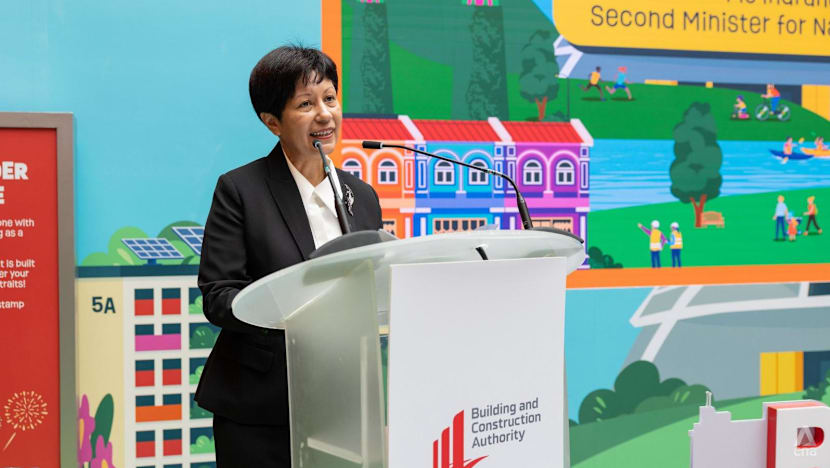Enhanced internship, higher starting pay among recommendations to draw architectural, engineering talent
The 11 recommendations from the task force for architectural and engineering consultants came about a year after it was formed.

Ms Indranee Rajah speaking at the launch of Building Singapore Festival at VivoCity on Sep 5, 2025. (Photo: Building and Construction Authority)

This audio is generated by an AI tool.
SINGAPORE: A task force for architectural and engineering consultants has proposed enhanced internships with higher starting salaries and dedicated mentors, among a list of 11 recommendations to drive talent to the built environment consultancy sector.
It comes as Singapore's long-term infrastructure plans, such as the Long Island, Greater Southern Waterfront and Changi Airport's Terminal 5 looms on the horizon.
“To turn these complex developments into reality, we need capable and passionate BE (built environment) professionals,” said Ms Indranee Rajah, Minister in the Prime Minister’s Office and Second Minister for National Development.
She added that a career in the built environment has a lasting impact.
"Their imprints can be seen all around us – whether it’s our towering skyscrapers, underground infrastructures or our homes,” she added.
Ms Indranee was announcing the recommendations at the launch of the Building Singapore Festival at the VivoCity atrium on Friday (Sep 5).
The task force was set up in September last year to attract more talent to work in the built environment sector and promote business sustainability. It was co-led by Ms Indranee and Mr Chaly Mah, chairman of Surbana Jurong Group.
It developed the report in collaboration with over 400 stakeholders through over 40 engagements and focus group discussions, said the Building and Construction Authority (BCA). Participants ranged from students and young professionals to senior leaders from the built environment and Institutes of Higher Learning (IHLs).
ENHANCED INTERNSHIPS
One key recommendation is for firms and IHLs to develop an enhanced internship programme amid difficulties attracting and retaining talent in the industry.
Named “INSPIRE”, the internship under the programme will last at least 30 weeks and expose interns to real-world projects. Interns will also be paired with mentors for guidance at the workplace.
Currently, civil engineering students typically undergo around 20 weeks of credit-bearing internship, while it is optional for architecture students to take up internships.
So far, the task force has received interest from more than 20 firms, including DP Architects, Beca, Arup and Surbana Jurong, to host interns under the programme.
Four IHLs offering built environment courses – Nanyang Technological University, National University of Singapore, Singapore Institute of Technology, and Singapore University of Technology and Design – will also participate in the programme.
There are about 50 internship slots available, and the BCA will continue to work with more companies to come on board.
The task force also highlighted the importance of having competitive salaries to attract talent, Ms Indranee said.
In 2022, CNA reported that low wages and long hours discourage young architecture graduates from staying in the industry. A 2021 survey by the Singapore Institute of Architects also found that only 7 per cent of young graduates said they were likely to stay in the profession in the long run.
Under the INSPIRE programme, interns can expect to earn at least S$1,500 a month. Upon returning to the company after graduation, they can expect to receive competitive starting salaries above prevailing market rates, BCA said.
Final-year architecture master’s student Sabrina Mahbub, who recently completed a three-month internship at architectural firm Aedas, said a longer stint will help students gain a more in-depth internship experience.
The mentorship component will also help architecture students who do not know much about the industry, said the 23-year-old.
“I do believe that the task force's recommendation will encourage more students to actually take on internships, because it will help them to get a head start on their career,” she said.
Institutes of higher learning will also update their curriculum to ensure that students can meet the industry’s future needs, Ms Indranee said.
For example, the National University of Singapore (NUS) College of Design and Engineering will include elements of sustainability and the circular economy into its curriculum.
SUSTAINABLE BUSINESS PRACTICES
To promote sustainable and profitable businesses, the task force also recommended that both public and private sector service buyers improve their procurement practices.
The authorities previously piloted a mechanism, known as the “Reduced Fee Score” in March 2024, designed to discourage fee undercutting and promote competition based on quality for projects.
Looking ahead, the authorities plan to expand this initiative to cover public sector projects from up to S$50 million currently, to S$100 million by the end of this year.
Additionally, the task force recommended that service buyers review contractual clauses to enable a fairer distribution of risks, preventing consultants from being overly penalised.
For example, by making the Limitation of Liability clause a default provision, professional liabilities will become more insurable and proportional to the fees, scale and complexity of consultancy projects.
Encouraging sustainable practices will enable firms to invest more in talent and innovation, said Mr Chuck Kho, president of the Association of Consulting Engineers Singapore (ACES).
“To pay our staff better, to have better development for them professionally, and invest in technology, etc, all these need a good stream of revenue,” he said.
“If we are always fighting on fees and basically squeezing ourselves, we will not be able to really sustain all this effort.”
POSITIVE WORK ENVIRONMENT
Beyond business practices, the task force also recommended firms to foster better work environments within the built environment sector.
In the same 2022 report, young architects told CNA that the industry was plagued by long hours and stressful work.
The task force has developed a Built Environment Culture of Appreciation, Respect and Empathy (BE CARE) Charter to outline best practice guidelines on how to strengthen workplace culture.
The charter includes pillars such as fostering openness and respect, ensuring smart meetings and communications and respecting rest periods.
So far, 34 firms, including GuocoLand and JTC, have committed to implementing the charter across their projects or firms.
The industry can access the charter on BCA’s website and pledge their commitment there.
Mr Galvin Chua, managing director of engineering and consulting service Beca, said that this move will help young engineers and architects realise that the built environment industry is not so “rough and so rugged”.
“We do better as a company, and also, in return, we pay better, and we can attract more people coming in,” he said.
SUPPORTING FIRM CAPABILITIES
Finally, the task force advocates for trade associations and chambers (TACs) to develop stronger in-house capabilities in areas such as sector branding, talent outreach, technology adoption and HR.
Firms, for example, have partnered with the Institute for Human Resource Professionals to enhance HR and career development capabilities.
They may also capitalise on technologies such as generative artificial intelligence to help architects and engineers work more effectively.
Ms Indranee said that TACs have the potential to amplify their impact and catalyse long-term growth of the sector.
“So I call upon the TACs to work and pool resources together to make this a reality,” she said.
















